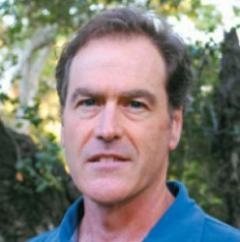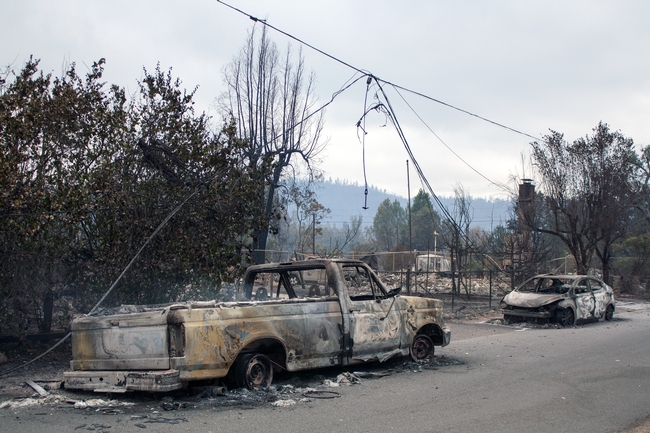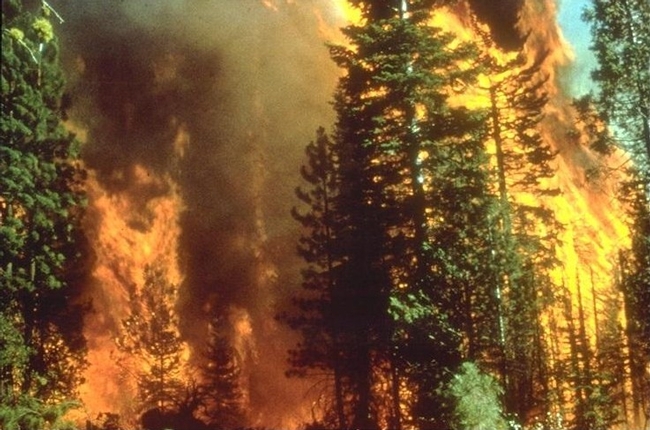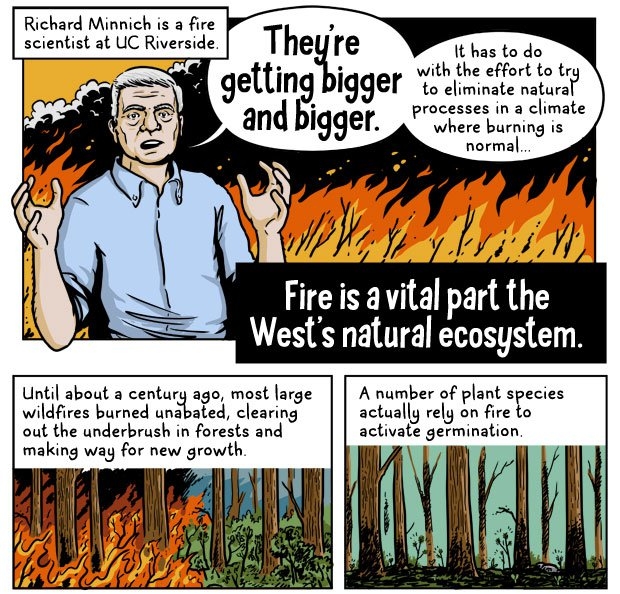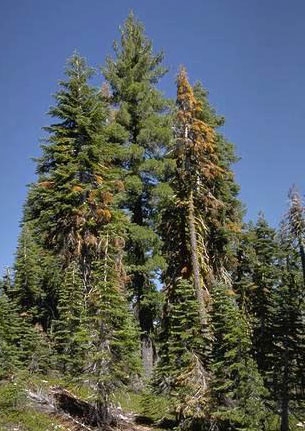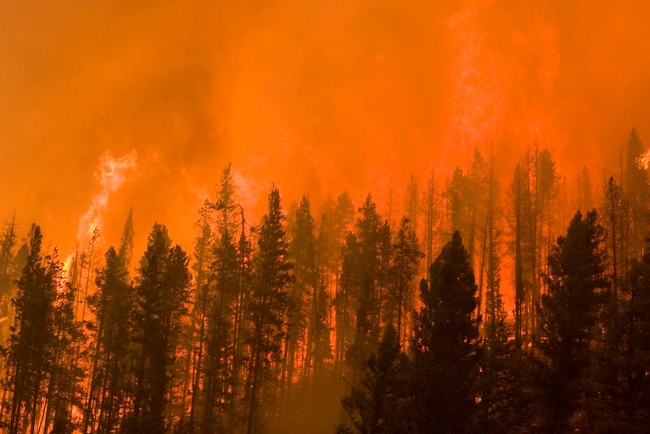Posts Tagged: Max Moritz
Both human and environmental factors responsible for intensifying wildfire
Climate change gets part of the blame for the growing frequency and intensity of wildfires in the western United States, but its not the only culprit, reported Jessica Mendoza in the Christian Science Monitor. A new study by UC Cooperative Extension specialist Max Moritz and Michal Mann, assistant professor of geography at George Washington University, found that human activity explains as much about their frequency and location of fires as climate influences.
Climate change affects the severity of the fire season and the amount and type of vegetation on the land, which are major variables in predicting wildfires. However, humans contribute another set of factors that influence wildfires, including where structures are built, and the frequency and location of ignitions from a variety of sources — everything from cigarettes on the highway, to electrical poles that get blown down in Santa Ana winds. As a result of the near-saturation of the landscape, humans are currently responsible for igniting more than 90 percent of the wildfires in California.
“More and more researchers are arguing that anthropogenic influences are really important [to understanding wildfires],” Moritz said. “By leaving them out we're missing a critical piece of the solution.”
While the U.S. Forest Service spends more than $2.5 billion each year fighting fires, other public agencies are exacerbating the wildfire problem. Public funds from the Department of Housing and Urban Development, for example, are going into construction in fire-prone districts.
"It's already a huge problem from a public expenditure perspective for the whole country,” Moritz said. “We need to take a magnifying glass to that. Like, ‘Wait a minute, is this OK?' Do we want instead to redirect those funds to concentrate on lower-hazard parts of the landscape?”
He said human systems and landscapes they live on are linked, and the interactions go both ways. Failing to recognize that leads to "an overly simplified view of what the solutions might be. Our perception of the problem and perception of what the solution is [becomes] very limited."
California wildfires are linked to climate change
In an article printed last week in the Los Angeles Times, fire scientists cast doubt on Gov. Jerry Brown's assertion that the intense wildfire season of 2015 was connected to global climate change. A UC Agriculture and Natural Resources (UC ANR) expert, however, responded with a letter to the editor that said publishing such information is "troubling."
"It's splitting hairs, as scientists often will, to note that we may not know conclusively whether climate change has caused this particular drought and these specific wildfires," wrote Max Moritz, a UC ANR Cooperative Extension specialist in the Department of Environmental Science, Policy and Management at UC Berkeley. "As a wildfire scientist, I find it troubling that this nuance became front-page news because it implies more uncertainty about climate change that there really is among experts."
Other writers' comments about the misleading article were also published. Alex Hall of the UCLA Center for Climate Change Solutions said "an analysis of the probability that the current fire season in California would play out as it has, if climate change were not in the picture has not been done." Jonathan Parfrey of Climate Resolve said "The Times really blew it in this piece."
In the conclusion of his letter, Moritz wrote: "In fact, there is relatively strong agreement among fire scientists about links between climate change and wildfire, even if quantitative attribution poses challenges. To raise awareness about climate change and to reduce its long-term impacts, we need our leaders to speak out."
Clever infographic outlines wildfire history in the American West
Moritz' 2014 research is titled Large wildfire trends in the western United States, 1984-2011. Warner also referenced an article by Moritz and colleagues published in Ecosphere called Climate change and disruptions to global fire activity.
Warner's infographic features images of and quotes by Richard Minnich, a UC Riverside earth sciences professor.
"They're getting bigger and bigger," Minnich is quoted in large, bold print in front of a blazing fire. "It has to do with the effort to try to eliminate natural processes in a climate where burning is normal."
Americans' resolve to quickly extinguish wildfires began after a devastating fire season in 1910, which burned millions of acres of forest and killed scores of firefighters. Aggressive firefighting efforts since then have changed U.S. forest ecology, providing excess fuel in forests that lead to larger, hotter blazes.
In order to protect people and property while maintaining forest health, American firefighting agencies and UC ANR researchers are seeking to adapt management strategies.
"There's been fire ever since there's been oxygen in the atmosphere," Minnich is quoted in a speech bubble. "It's been going on for a third of a billion years, and it's not as though we're ever going to stop it."
Trees dying due to drought are prone to wildfire
Across California, pine trees that have been weakened by the drought are having trouble defending themselves from bark beetles, causing widespread tree death. The dead trees won't cause fires, but when ignited they will be hotter and be more difficult to control, according to articles that ran over the weekend in the Santa Rosa Press-Democrat and the Desert Sun.
“Statewide, it's horrific,” said Greg Giusti, UC ANR Cooperative Extension advisor.
Max Moritz, UC ANR Cooperative Extension specialist in fire ecology, described the combination of exceptionally low vegetation moisture and widespread plant deaths as "a double-barreled threat."
"On top of the dry conditions, it's been unusually hot in many, many parts of the state," Moritz said. "We do have a pretty exceptional fire season stacking up, or the potential for one."
The Los Angeles Times also covered the story earlier this month.
Scott Stephens, fire science professor at UC Berkeley, said fire suppression and harvesting have made forests more dense over the last 100 years. The increased density has made trees more vulnerable as they compete for limited amounts of water, with the weaker trees more susceptible to bark beetle infestations, he said.
“If the drought continues for another two years or longer, I expect this mortality to move throughout the state,” Stephens said. “Forests that once burned frequently with low-moderate intensity fire regimes are the most susceptible.”
New perspective needed on Western wildfire
“To reduce flood damage, we make floodplain maps. To reduce earthquake damage, we form earthquake commissions. When it comes to fire, we hand everything over to the firefighters," said Max Moritz, UC Cooperative Extension specialist in the Department of Environmental Science Policy and Management at UC Berkeley. He is the lead author of a review paper about wildfire published today in the journal Nature.
The analysis looked at different kinds of natural fires, what drives them in various ecosystems, the ways public response to fire can differ, and the critical interface zones between built communities and natural landscapes. Moritz and his co-authors conclude that government-sponsored firefighting and land-use policies actually encourage development on hazardous landscapes, amplifying human losses over time.
“We don't just have a forest-fire problem,” Moritz said. “We have a shrubland-fire problem, a grassland-fire problem, and a woodland-fire problem. And the more we rely on fuels reduction to protect us, the more energy we're taking away from measures that could really make a difference.”
For more on the research, see
- Co-exist or perish, wildfire analysis says, UC Berkeley press release
- Wildfire-Prone Areas Need to Learn to Live With Flames, Experts Say, NBC news
- Misguided Wildfire Policy Should Change, Scientific American
- As Wildfires Worsen, Calls for Change in Tactics, USA Today
- New global wildfire analysis indicates humans need to coexist and adapt, University of Colorado, Boulder


